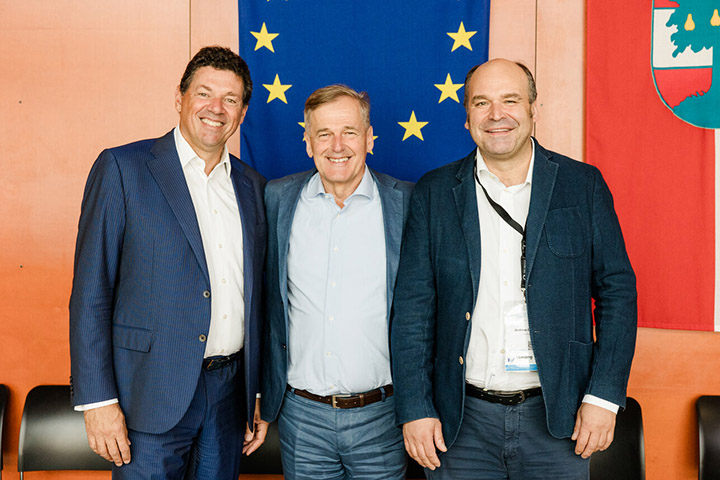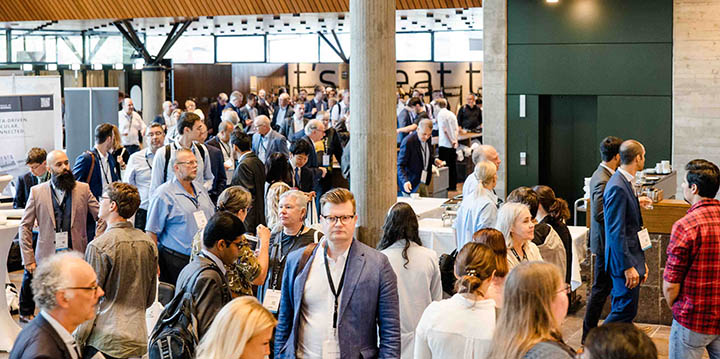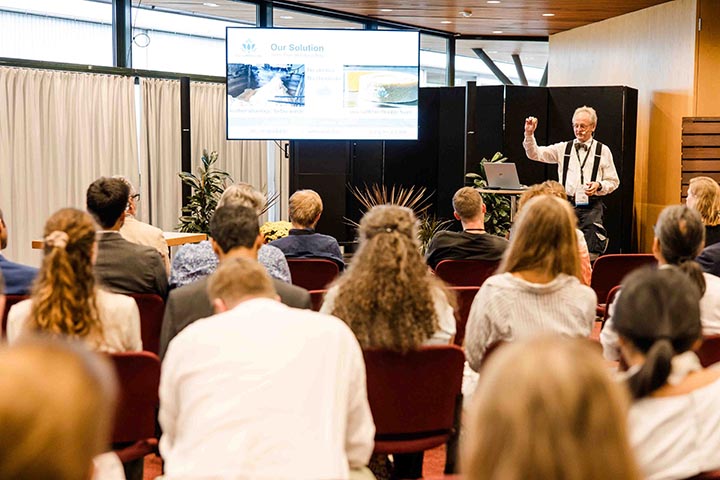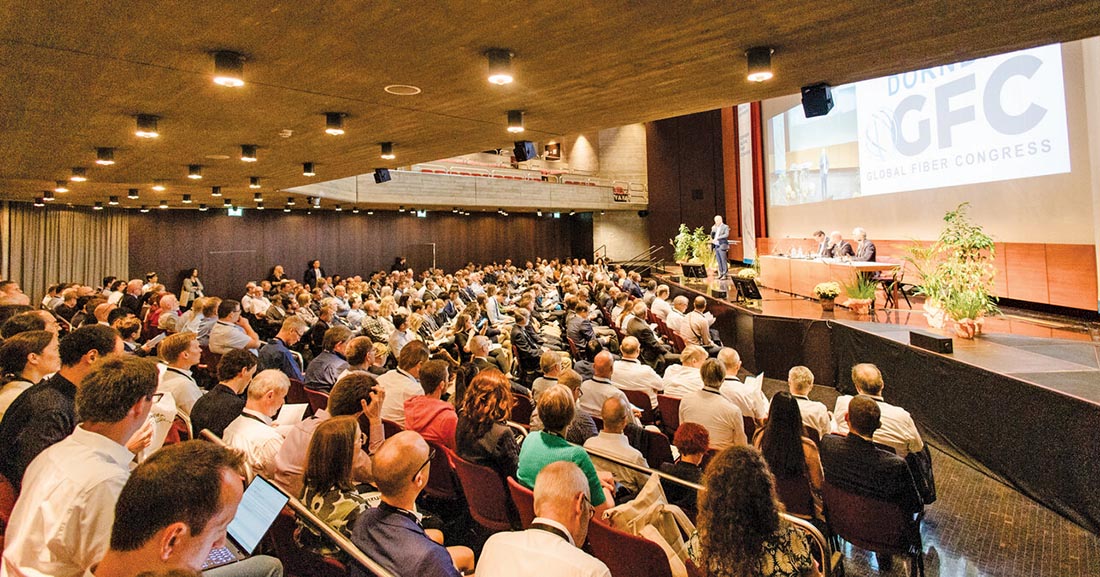Fundamental Changes are Required to Support Circular Ideas
For three days each year in September, Dornbirn in western Austria – one of the smartest cities in Europe – is the center of the textile world, with networking and cross-industry partnerships beginning to bear fruit.
The fibers sector faces tough challenges in the years leading up to 2030 and beyond. Difficult – and critical choices – will have to be made about raw materials, energy sources, products and processes, a major international conference was told.
While the circular economy and recycling continue to be the main issues facing the fiber and textile industry, legislation appears to be the key agent that will drive circularity and force major change in global supply chains. In the European Union (EU), for example, a strategy on textiles is being translated into regulations as a new initiative on recycling textile waste is launched.
For synthetic fibers the message is clear – the industry needs to move away from petroleum-based raw materials toward renewable and recyclable material inputs. But while fibers, and therefore textiles, remain an environmental problem, they are here to stay; polyester, in particular, will not disappear any time soon.
Fundamental Change Required
Despite the difficult economic and geo-political climate, more than 550 participants from over 30 countries attended the 62nd Dornbirn Global Fiber Congress (GFC), which featured around 125 presentations on fiber innovation, recycling, circular economy, sustainability, nonwovens, technical textiles, sports and apparel.
Opening the congress, Robert van de Kerkhof, chief sustainability officer of Austria-based cellulosic fibers producer Lenzing and president of the Dornbirn GFC, said: “The challenges currently facing the fiber industry require fundamental changes in the value chains. We see new strategic partnerships being formed to take advantage of new opportunities around innovation, the circular economy and new business models. Dornbirn GFC shows once again that it is the perfect place for such new partnerships.”

Healthy Growth Potential
Stephan Sielaff, chief executive officer of Lenzing, noted that while the global fiber market has seen many challenges since the 1960s, it has always recovered. It continues to show a healthy growth potential, with an average annual increase of 2.4% predicted by 2030, which means an additional demand of 27 million tonnes a year of fibers.
The key drivers of this growth are an increase in the global population, a rise in the middle class, especially in Asia, and more “conscious” consumers, said Sielaff.
He noted that of the total man-made fibers market, synthetic fibers currently account for 92% with a forecast growth rate of 2.7% per annum to 2030, which translates to an additional 20 million tonnes a year.
Cellulosic fibers currently account for 8% with a forecast growth rate of 5.6% per annum to 2030 – an additional four million tonnes a year. However, growth in natural fibers is expected to remain flat owing to pressures on land use and other environmental concerns.
“The fashion industry is heavily criticized for its impact on the environment, and consumers really do care about the products they buy and also about the processes,” said Sielaff. “At the same time, consumers are overwhelmed about their purchasing decisions.
“They rely on brands that give them a promise that the products they buy are sustainable and we [the fiber industry] have to help them to ensure that the brands follow those promises – without confusing them.”
Sielaff noted that 20% of all women’s garments bought in Germany, for example, are worn “less than once” – the percentage for men is even higher. “Our value chain is creating waste, during and after the manufacturing process,” he said. “We are still using virgin material today, depleting resources, and we are throwing away the products at the end of their use – this is not sustainable and has to change.
“But we can make this value chain more sustainable; the key is networking. Circularity is the key driver, moving away from a linear business model. We should buy less and buy more consciously.
“And circularity starts with the design of a product. Producers have to play a role, making the right products using the right processes. So, we should stop using coal, phase out natural gas and use more green energy – and work on more fiber-to-fiber solutions.”

EU Textile Strategy
The EU textile industry is moving from being a fairly unregulated sector to becoming a highly regulated one, according to Dirk Vantyghem, director general of Euratex, the European Apparel and Textile Confederation.
He said European institutions are making rapid progress in implementing the EU Strategy for Sustainable and Circular Textiles, which was launched in 2022. The framework will introduce 16 separate pieces of legislation that companies have to comply with, although this is still under negotiation.
“There is a lot of textile-bashing in the media and a lot of confusion about textiles, but we need to be very clear in our communication about how the industry is making efforts to become more sustainable,” said Vantyghem. “We also have to be more transparent in our communication. For example, today there are more than 100 sustainability labels.
“We are at a crossroads and there will be many changes and casualties, as well as a lot of new start-ups. But we need to join forces and work together more than ever within the textile value chain.
“The EU’s new framework of rules and regulations will see the market move from being based solely on free trade to free-but-fair trade, and it is essential to create a level playing field for all operating within it,” he said.
Vantyghem said European companies are committed to investing in sustainability, developing new circular business models and producing high-quality textile products as required by the new legislation.
“We are working in Brussels to ensure a clear and coherent regulatory framework that is realistic, enforceable and not damaging to small and medium-sized enterprises,” he said. “And all of this has to be developed in a global context to ensure the EU strategy becomes a global strategy.”
ReHubs Initiative
It is estimated that Europe produces around 7.0–7.5 million tonnes of textile waste a year, of which only 30–35% is currently collected. An amendment to the EU Waste Framework Directive will see mandatory separate collection of textile waste coming into force on January 1, 2025.
Euratex has welcomed the EU’s regulatory effort to solve the problem of waste, both to reduce waste and to enable textile waste recycling. And in October, it officially launched a new non-profit organization that aims to boost textile recycling.
ReHubs Europe will gather key players from the textile value chain, including manufacturers, fashion brands, collectors and recyclers, as well as chemical industry and technology providers, with the ambition of recycling 2.5 million tonnes of textile waste by 2030.
This will require up to 250 industrial projects across Europe, covering different types of fiber-to-fiber recycling, and an investment of €6–7 billion to scale up a sufficient sorting and processing infrastructure.
ReHubs estimates that the economic, social and environmental value of the initiative could be worth €3.5–4.5 billion a year by the end of the decade and create around 15,000 new direct jobs.
Chris Deloof will lead ReHubs Europe as executive director. The organization will operate from Brussels, Belgium, in close partnership with Euratex. Membership is open to any companies who wish to invest in textile waste recycling in Europe.
Meanwhile, led by Switzerland-based Texaid, a leading European organization for collecting, sorting and recycling used textiles, “Transform Waste into Feedstock” has been announced as the first project supported by ReHubs, which aims to build up a 50,000-tonnes capacity facility by 2024.
New World Order
In a comprehensive overview of global trade and the new world order, Giuseppe Gherzi, CEO of textile management consultancy Gherzi Engineering, Switzerland, stated that India will soon become the world’s largest consumer market for textiles and footwear, overtaking China, while Nigeria, with a forecast population of 730 million in 2045, will also catch up.
He said total fiber consumption in 2022 was 120 million tonnes, with filament dominating with 62 million tonnes and polyester the leading fiber material; Gherzi expects total global consumption to rise to 140 million tonnes by 2030.
However, consumption of traditional textiles, especially garments, will increase very little in future owing to more reuse and resale, he said. The biggest growth will be in nonwovens, as well as prepreg/composites and technical textiles.
In addition, around two million tonnes of fibers are currently recycled per year using mechanical recycling methods, which is forecast to increase to 10 million tonnes by 2030.
Gherzi believes the mid-price garment sector will shrink in favor of both luxury products and the low-price segment, with department store sales losing significant market share and online sales growing.
He noted that while more than half of the global labor force (aged 15–64 years) is in the Asia-Pacific region, this share is expected to gradually decline, while the proportion in Africa and the Americas will rise.
Innovation Days
The Third Innovation Days at this year’s Dornbirn GFC featured 25 start-up companies presenting their novelties in a fourth lecture hall, as well as a meeting point with delegates in the foyer of the Dornbirn Kulturhaus.
“Dornbirn GFC is a great opportunity for innovators to meet the decision makers in the fiber and textile industry,” said Bjol Frenkenberger of MIR Insight, Norway, one of the participants in the conference-within-a-conference. “The congress with its focus on innovation and research offers an inspiring environment for high-quality contacts.”

Meanwhile, a special block of lectures during the congress was the result of cooperation on the topic of sustainability and the circular economy between RWTH Aachen University, Germany and European industry partners. Texaid started this section of presentations, discussing how spinning mills turn recycled material into yarn.
Dornbirn Awards
During the congress opening, the Paul Schlack/Wilhem Albrecht 2023 prize was awarded to Dr. Henriette Grellmann for her work at the Institute of Textile Machinery, Technische Universität Dresden, Germany, on the development of textile-based actuator and sensor systems for adaptive fiber-elastomer composites.
The second honorary prize was awarded to Dr. Tim Höhnemann of the German Institutes for Textile and Fiber Research (DITF), Denkendorf, Germany, for his work on the generation of monofilaments with defined cross-sectional shape from polymer melt, in work carried out at the Friedrich-Alexander-Universität Erlangen-Nürnberg, Germany.
Meanwhile, a jury of experts from the fiber industry selected two winners of this year’s Lenzing Young Scientist Award: Nina Sirén, a student at Aalto University, Finland, for her study comparing pre-
consumer modal with modal recycled using the Ioncell process, and Clara Davis, a researcher at Eurecat – Centro Tecnológico de Cataluña, Spain, for her work exploring the potential of using bacterial nanocellulose as a tree-free feedstock for regenerated cellulose fibers.
Management Change
During the reception hosted by the Mayor of Dornbirn, Andrea Kaufmann, it was announced that Friedrich Weninger, who has organized the fiber conference as managing director of the Austrian Fiber Institute since 2015, will step down over the next two to three years, allowing Andreas Dorner, currently director, commercial fibers, Europe and Americas, at Lenzing, to take over management of the event,
initially as co-managing director.
The 63rd Dornbirn GFC is scheduled for September 11–13, 2024 in Dornbirn. The topics of circular economy, recycling and sustainability will continue as main themes, alongside nonwovens and technical textiles. www.dornbirn-gfc.com


